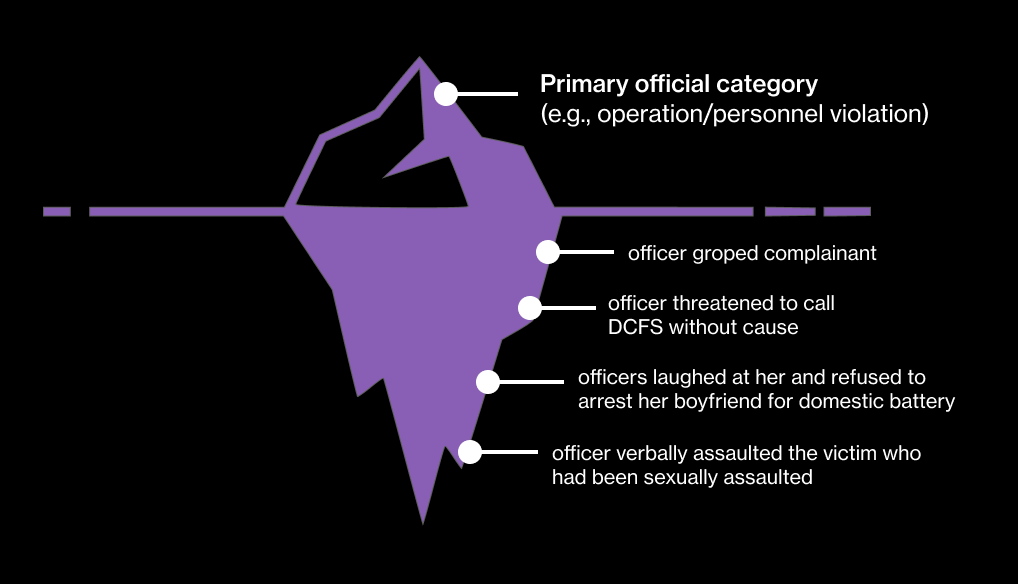What is Beneath the Surface?
We created Beneath the Surface to go beyond the official primary categorization of police complaints and bring to the surface the voice, experience, and often hidden allegations of survivors of state and interpersonal violence. Often, allegations from people who report state violence are either buried, miscategorized, or not adequately investigated.
Survivors of gender-based violence often face the additional harm of isolation, which can cause them to internalize their experience as being their fault. Scientific evidence and investigative reports reveal that because of the reality of failed accountability, the fear or misunderstanding about filing complaints, and other obstacles to reporting, incidences of violence and misconduct are underreported and what we know about represents only a fraction of actual instances of misconduct.
As the volume of police complaints comes to the surface, and the actual content of testimonies is unearthed, our data analysis seeks to connect those impacted by state violence and demand redress for these human rights violations.
By reading the full narrative text of these complaints, we were able to identify a lack of clarity around primary categorization as it related to the lived experiences of those making complaints. Access to underlying documents reveal that while a primary categorization may name one issue, the narratives in the underlying documents reveal, among other things, sexual violations at the hands of police.
The City of Chicago finds the majority of complaints “unfounded” or “unsustained,” which means the complaint was found to not be true or there was a limited investigation before being closed. Regardless of any individual complaint’s validity, we can still see and identify patterns of allegations that emerge from this mass of complaints.
Because the City has yet to release most of the underlying investigation files, we do not have access to and therefore are not in a position to do a thorough auditing of many of these complaints.
However, taken as a whole, these patterns have evidentiary weight.
Today much of the research done in Chicago and across the country centers on use of force, arrests, and complaint data with respect to Black men. Statistics about the experiences of Black women and transgender people are often incomplete or missing entirely. Because researchers rely on high-level police data to frame research and policy, patterns of gender-based violence in these encounters remain largely invisible, allowing abusive officers to continue to act with impunity.
Diane Bond, photoset by Patricia Evans
How did we discover these hidden human rights violations?
The City of Chicago has long fought against making police complaint records publicly accessible. The documents we have access to are indebted to citizens determined and brave enough to report their encounters with police and those who fight to make these documents publicly available.
The issue of whether officers’ disciplinary histories should be public entered litigation in 2005, when a survivor of police violence, Diane Bond, sued the Chicago Police Department. Her case, Bond v. Utreras, enabled the public to access some Chicago Police misconduct records, and it led to the landmark decision in Kalven v. Chicago (2014) in which the Illinois Court of Appeals held that police misconduct records belong to the public.
In the wake of the Kalven decision, we gained access to massive spreadsheets of police disciplinary data, and in 2015 we created the Civic Police Data Project (CPDP.co), which houses Chicago police misconduct data between 1988 and 2018.
This database of nearly 250,000 allegations does not tell the full story. Our aim with Beneath the Surface is to emphasize that each complaint record alleging police misconduct is also a deeply personal story of a person’s encounter with the police. Spreadsheet-level data does not include complainant testimony, whereas the underlying investigative files allow us to read the full narrative of the report, revealing more detailed, often troubling and violent allegations than the data suggests.
These are not the only types of alleged human rights violations obscured. We identified other abuse allegations, including domestic violence, sexual assault response, home invasions, issues involving children, and more.
Our goals are to unearth this pattern of burying human rights violations, support survivors using data analysis, expand the discussion about police misconduct, and demonstrate the importance of making these investigative records available to the public.
For instance, in Complaint Record (CR)# 1019178, Officer Christopher Griggs is accused of improperly searching two Black women.
In the spreadsheet-level data, the complaint is categorized as illegal search. But when we read the text in the underlying documents, we see an additional allegation about a sexual violation. When complainants report sexual misconduct or violence by police, the allegation often gets buried through official coding procedures by highlighting a primary categorization for the complaint and leaving additional allegations obscured in the underlying narrative.






